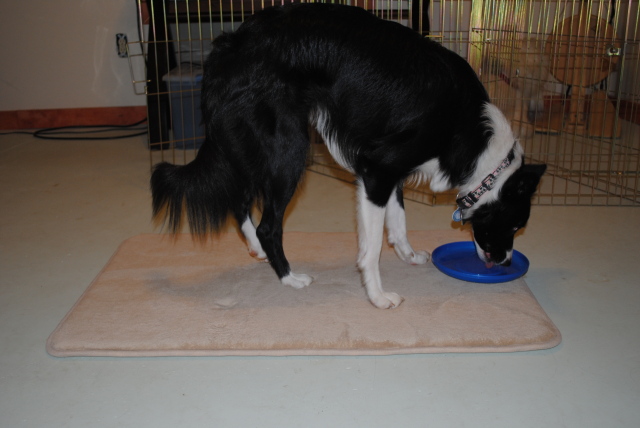QuestionHi Chris and Beth,
I'm about to lose my mind and hope you can help. I rescued two mixed breed sisters about 8 mo old. Sadie, weighs at least 80 lbs. and Maggie weighs about 50 lbs. Maggie had lost her back right leg in a car accident. We've had both dogs for about a month. They are both very friendly but OVER zealous. When we let them in the house or go into the back yard they go nuts. Sadie literally almost knocks me down (I'm 110 lbs.) and our 5 year old daughter doesn't stand a chance with their excitability and is afraid to go in the yard or have them in the house. I'm starting to dread it myself and looking for another home for them is starting to sound like a great idea.
All suggestions are appreciated. I've tried knee in the chest, grabbing front paws, stepping on back paws (yea right, Sadie comes up to my shoulders when standing on her hind legs:-), ignoring the behavior in spite of feeling like I'm being maulded:-), saying "off", praising when they are on all fours.
Help!!
Thank you so much,
Sandra
AnswerSandra,
DO NOT GIVE UP! If you (and your family) are willing to commit to teaching Sadie and Maggie which of their behaviors are appropriate and which are inappropriate for eliciting attention, you should find living with 2 large dogs more pleasant. I have worked with literally hundreds (maybe thousands) of cases exactly like this, and I have NEVER seen a dog not respond. Of course, this assumes owner compliance (obviously, if the owner does not follow recommendations, there is very little chance of success!). Sounds silly, but you'd be surprised...
Some of the techniques you mentioned can work if implemented correctly and consistently. We encourage using positive training methods rather than corrective techniques based on force or intimidation (i.e. knee to the chest, stepping on paws, etc). Remember that dogs depend on their owners to teach them how to behave appropriately within a "human pack." Everyone in the household (including supervised children) should agree on and consistently enforce house rules.
One suggestion is to first try the commonly used technique of removing the rewards. Currently, your dogs are being rewarded with exactly what they want... your attention. To your dog, even bad attention is better than no attention. In this case, your dogs need to learn that their current method of attention seeking will result in the immediate loss of attention (the opposite of what they want) and, equally important, they will learn that attention is earned by good behavior. Every time a human comes in the room and is met with a dog paw, IMMEDIATELY put the dog in a 2 minute time-out. Quickly usher the dog(s) straight to their crate(s). If they have no crate, use a leash to tether the dog(s) to a secure, safe, and supervised location. It is important to 1) avoid giving any attention (no eye contact, talking, yelling, etc.) and 2) be consistent in ignoring the behavior you wish to get rid of. After 2 minutes, release the dog(s) and repeat as necessary. The only caveat is that crying/whining dogs must remain in time-out until quiet because this is another attention seeking behavior that should be ignored. Also remember to give praise and attention when your dog is engaging in behaviors that you approve of (standing with all 4 feet on the floor, sitting, lying down, etc.).
Enrolling in an obedience class in your area will teach you how to train your dog(s) to listen even in distracting environments. Group classes are an excellent place to get feedback on your training techniques and to hone your dog's listening skills in a distracting environment. When your dog will "sit" or "down" with distractions (ie people entering the house), you can replace jumping up by asking your dog for a behavior that is incompatible with jumping. Being able to send your dog to a crate or bed is another useful command. There are some games that can be fun for children and family dogs to help reinforce the notion of not jumping, too.
The time-out technique we have described here is only one of about 6 methods we use in the treatment of jumping. Hopefully you'll find this information helpful. When we work with clients, we typically see ~75% of jumping disappear within the first week. You may find different results working alone; if you find that you need further assistance, don't hesitate to contact us. If you visit our website downstay.com, you will find information and links that might be helpful to you (in particular, take a look at http://downstay.com/docs/crate-training.doc and http://downstay.com/docs/handling-bad-behaviors.doc). We recently moved out of our "brick and mortar" training facility in CT so that we can travel and train dogs throughout the U.S. We are currently available for phone consults (860-517-6008) and we continue to offer private obedience and behavior lessons (we are currently in New England).
Best of luck to you,
Chris & Beth
(with help from Brandy, Asia, Brodie, Fenris, and Loki)
d o w n s t a y . c o m
860-517-6008

 Peeing on edge of training pad
QuestionI have a 3 year old Poodle who has been house t
Peeing on edge of training pad
QuestionI have a 3 year old Poodle who has been house t
 Housebreaking My Puppy and Choosing the Right Fencing
Question
Woody
Hello. I have a four month old be
Housebreaking My Puppy and Choosing the Right Fencing
Question
Woody
Hello. I have a four month old be
 Shih tzu toilet training
Question
Shih Tzu Chihuahua
We have a Shihtzu/Chihuahua
Shih tzu toilet training
Question
Shih Tzu Chihuahua
We have a Shihtzu/Chihuahua
 dealing with a blind 5yr old Cavalier
Question
Skipper
I have a lovely, 5 yr old Caval
dealing with a blind 5yr old Cavalier
Question
Skipper
I have a lovely, 5 yr old Caval
 bladder issues in rescue pups
Question
collie-shepherd pups
We have had two rescued s
bladder issues in rescue pups
Question
collie-shepherd pups
We have had two rescued s